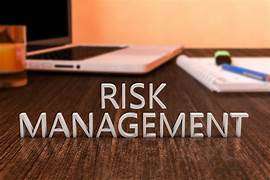
Crypto Trading Risk Management Free Course
Effective risk management helps mitigate emotional decision-making, enabling traders to stay calm and focused
Trading Risk Management: In the ever-evolving landscape of cryptocurrency trading, where fortunes can be made and lost in the blink of an eye, the importance of proper risk management cannot be overstated.
Trading Risk Management
The allure of quick profits often overshadows the necessity of protecting one’s investments, leading many traders to disregard essential risk management practices. To address this critical aspect of trading, a comprehensive Crypto Trading Risk Management Free Course has been developed, aiming to equip traders with the knowledge and tools needed to navigate the volatile waters of crypto markets while safeguarding their capital.
What is Risk Management in Crypto Trading?

Risk management in crypto trading refers to the set of strategies, techniques, and principles traders employ to minimize potential losses while maximizing profit potential. It’s a structured approach that involves analyzing, assessing, and mitigating various risks associated with trading cryptocurrencies. The primary goal of risk management is to protect one’s capital from substantial losses, allowing traders to participate in the market with a level of confidence and security.
5 Importance of Risk Management in Crypto Trading

- Preservation of Capital: The most fundamental aspect of risk management is capital preservation. By employing prudent risk management practices, traders can ensure that they don’t lose a significant portion of their investment due to unfavorable market movements.
- Reduced Emotional Stress: Cryptocurrency markets are notorious for their extreme volatility, which can trigger emotional responses among traders. Effective risk management helps mitigate emotional decision-making, enabling traders to stay calm and focused even during turbulent market conditions.
- Long-Term Sustainability: Consistently practicing risk management leads to sustainable trading over the long term. Traders who disregard risk management are more likely to suffer significant losses that could potentially wipe out their trading accounts.
- Enhanced Decision-Making: Risk management encourages traders to analyze various factors before executing trades. This analytical approach results in more informed and rational decisions, reducing impulsive actions that can lead to losses.
- Diversification Opportunities: Proper risk management opens doors to diversification strategies, allowing traders to spread their investments across different assets and markets. This diversification helps mitigate the impact of a single asset’s poor performance.
5 Popular Mistakes of Crypto Traders

- Overleveraging: One of the most common mistakes is using excessive leverage, which amplifies both profits and losses. Traders who overleverage their positions are at risk of losing their entire investment rapidly.
- Ignoring Stop-Loss Orders: Neglecting to set and follow stop-loss orders can result in substantial losses. Stop-loss orders act as safety nets by automatically closing positions when a predetermined price level is reached.
- Lack of Research: Failing to conduct thorough research before investing in a cryptocurrency can lead to poor decision-making. Traders should understand the technology, market trends, and potential risks associated with each asset.
- Chasing Losses: Trying to recover losses by making impulsive trades, known as revenge trading, often exacerbates losses. Emotional decisions in an attempt to make up for past losses can lead to a downward spiral.
- Overtrading: Trading too frequently, especially in volatile markets, can lead to unnecessary transaction costs and increased exposure to risk. It’s important to have a well-defined trading strategy and stick to it.
5 Risk Management Techniques to Follow

- Position Sizing: Determine the appropriate size of each trade based on your total capital and risk tolerance. Generally, it’s advisable not to risk more than 1-2% of your trading capital on a single trade.
- Diversification: Spread your investments across different cryptocurrencies to reduce the impact of poor performance in a single asset. This diversification helps balance risk exposure.
- Set Stop-Loss and Take-Profit Levels: Always define your exit points before entering a trade. Set stop-loss orders to limit potential losses and take-profit orders to secure profits at desired levels.
- Risk-Reward Ratio: Evaluate the potential reward in relation to the risk of a trade. A common guideline is to aim for a risk-reward ratio of at least 1:2, where the potential reward is at least twice the potential risk.
- Use of Risk Management Tools: Various risk management tools, such as trailing stop-loss orders and hedging strategies, can be utilized to enhance risk management capabilities.
Three Concepts of Trade and Risk Management

In the dynamic world of trading, successful outcomes are not solely determined by the ability to predict market trends, but also by the skillful implementation of trade and risk management strategies. Three essential concepts within this framework are Stop Losses, Position Sizing, and Scaling. Each of these concepts plays a crucial role in minimizing losses, optimizing profits, and ensuring the long-term sustainability of a trader’s portfolio. Let’s delve into each concept extensively.
1. Stop Losses: Protecting Capital from Downside Risk
A stop loss is a predefined price level at which a trade is automatically closed to limit potential losses. It serves as a safety net, protecting a trader’s capital from significant downward price movements. The fundamental idea behind stop losses is to establish a point of exit that prevents a small loss from turning into a catastrophic one. There are several types of stop loss orders, each with its own merits:
- Fixed Dollar Stop Loss: This involves setting a specific dollar amount as the maximum acceptable loss for a trade. For instance, if a trader invests $1,000 in a trade and sets a $50 fixed dollar stop loss, the trade is automatically closed when the loss reaches $50.
- Percentage-based Stop Loss: This type of stop loss is calculated as a percentage of the trader’s account balance or the trade’s initial investment. For instance, a trader might set a 2% stop loss on a trade to ensure that losses don’t exceed 2% of their total capital.
- Volatility-based Stop Loss: This approach takes into account the asset’s historical volatility. The stop loss is set at a distance from the entry price proportional to the asset’s typical price fluctuations.
2. Position Sizing: Calculated Allocation for Each Trade
Position sizing involves determining the appropriate amount of capital to allocate to each trade based on a trader’s risk tolerance and account size. This concept is closely tied to risk management as it ensures that no single trade can significantly impact the overall portfolio. Effective position sizing balances potential gains with acceptable losses, promoting sustainable trading.
Key components of position sizing include:
- Risk Per Trade: This refers to the maximum percentage of capital a trader is willing to risk on a single trade. A common rule of thumb is to risk no more than 1-2% of the total trading capital per trade.
- Trade Size Calculation: The trade size is calculated based on the risk per trade and the stop loss distance. By dividing the risk per trade by the stop loss amount, traders can determine the trade size that aligns with their risk tolerance.
- Diversification: Position sizing also facilitates diversification. By allocating different trade sizes to various assets, traders can reduce the impact of poor performance in a single trade on the overall portfolio.
3. Scaling: Adjusting Position Sizes as Conditions Change
Scaling involves adjusting position sizes based on changing market conditions, trade performance, and risk levels. Scaling strategies allow traders to capitalize on profitable trends and mitigate exposure during periods of high volatility. There are two primary scaling approaches:
- Upward Scaling: When a trade is performing well and moving in the desired direction, traders might choose to increase their position size. This allows them to capitalize on a trend that’s gaining momentum. However, upward scaling should be executed cautiously, as it amplifies both profits and losses.
- Downward Scaling: In volatile markets or when trades aren’t going as planned, traders might reduce their position sizes to limit potential losses. This conservative approach helps safeguard capital during uncertain times.
Scaling also requires continuous monitoring and adjustment of trade sizes to account for changing market conditions and evolving risk profiles.
Crypto Tips for Risk Management

Trading in the cryptocurrency market offers immense profit potential, but it also presents substantial risks due to its inherent volatility and unpredictability. To navigate these treacherous waters successfully, adopting robust risk management practices is essential. Here, we’ll delve into three critical crypto tips for risk management: capital allocation, calculating risk/reward ratio, and using stop loss orders.
1. Capital Allocation: Safeguarding Your Resources
One of the fundamental principles of risk management is capital allocation, which involves determining the portion of your trading capital to invest in any given trade. By allocating a specific percentage of your capital to each trade, you limit the impact of potential losses on your overall portfolio. Here’s how to effectively manage your capital:
- Set a Maximum Risk Per Trade: Decide on the maximum percentage of your capital you’re willing to risk on a single trade. This figure should typically range from 1% to 2% of your total trading capital. This strategy ensures that even a series of losing trades won’t significantly deplete your resources.
- Avoid All-In Approach: Never put all your capital into a single trade. Diversification is key to mitigating risks. Spreading your capital across multiple trades reduces the impact of a single loss on your overall portfolio.
- Consider Correlation: When diversifying, consider the correlation between different cryptocurrencies. Avoid allocating a large portion of your capital to assets that move in tandem, as this diminishes the diversification benefits.
2. Calculating Risk/Reward Ratio: Assessing Trade Viability
The risk/reward ratio is a powerful tool for evaluating the potential profitability of a trade relative to its associated risk. It’s the ratio of the potential reward (profit) to the potential risk (loss) of a trade. Calculating this ratio helps you make informed decisions about which trades to pursue and which to avoid.
- Identify Entry, Stop Loss, and Take Profit Levels: Before entering a trade, determine the entry price, stop loss level, and take profit target. This information is crucial for calculating the risk/reward ratio.
- Calculate Risk and Reward: Subtract the stop loss price from the entry price to determine the potential loss per unit. Similarly, subtract the entry price from the take profit target to calculate the potential gain per unit.
- Compute the Ratio: Divide the potential gain by the potential loss to obtain the risk/reward ratio. A ratio greater than 1 indicates that the potential reward outweighs the potential risk.
- Opt for Favorable Ratios: Aim for risk/reward ratios of at least 1:2 or higher. This ensures that even if only half your trades are successful, you can still be profitable overall.
3. Use of Stop Loss Orders: Preventing Catastrophic Losses
A stop loss order is a critical tool in risk management that helps you limit potential losses by automatically closing a trade at a predetermined price level. Using stop losses effectively can help protect your capital from significant downward price movements.
- Set Logical Stop Loss Levels: Determine your stop loss level based on technical analysis, support/resistance levels, and market trends. Avoid placing stop losses too close to the entry price, as this can result in premature exits due to market noise.
- Avoid Emotional Decision-Making: Relying on stop loss orders takes emotions out of the equation. It prevents you from making impulsive decisions driven by fear or greed when the market experiences sudden volatility.
- Regularly Adjust Stop Loss Levels: As a trade progresses, consider trailing your stop loss to lock in profits or minimize potential losses. Trailing stop loss orders automatically adjust as the price moves in your favor.
- Stick to Your Strategy: Once you set a stop loss, stick to it. Avoid manually moving it unless there’s a valid reason based on updated analysis.
5 Tips to Avoid Revenge Trading

- Take a Break: After a significant loss, step away from trading for a while to clear your mind and emotions.
- Analyze Losses Objectively: Understand why the loss occurred and learn from your mistakes rather than rushing into trades to recover losses.
- Set Daily Limits: Establish a maximum number of trades or a daily loss limit to prevent overtrading and impulsive decisions.
- Journal Your Trades: Maintain a trading journal to track your emotions, decisions, and outcomes. This reflection helps identify patterns and areas for improvement.
- Seek Professional Help if Necessary: If you find yourself consistently falling into the trap of revenge trading, consider seeking advice from a mentor or a professional trader.
Best App to Sell Crypto in Nigeria Fast
In the Nigerian cryptocurrency market, where speed and efficiency are paramount, the “Dtunes App” emerges as the go-to solution for selling cryptocurrencies swiftly and securely. This app offers seamless transactions, competitive rates, and a user-friendly interface, ensuring that Nigerian traders can convert their digital assets into local currency with minimal hassle.
In conclusion, the Crypto Trading Risk Management Free Course provides traders with a comprehensive toolkit to navigate the complex world of cryptocurrency trading while safeguarding their investments. By understanding the concepts of risk management, avoiding common mistakes, following proven techniques, and adhering to expert tips, traders can enhance their chances of success in the volatile crypto markets. With the right knowledge and skills, traders can embark on their trading journeys with confidence, resilience, and a solid foundation for risk management.
Tobi brings stories to life as the Content Writer and Creator at Dtunes, blending creativity with strategy to connect with audiences. When she’s not crafting content, you’ll find her traveling, meeting new people, or trying out exciting things.




